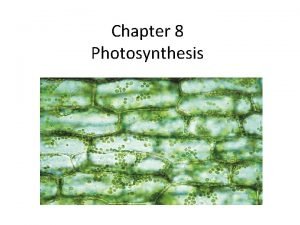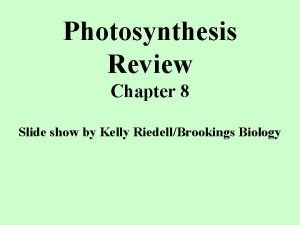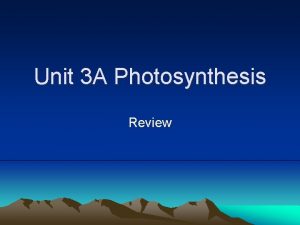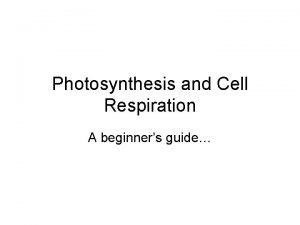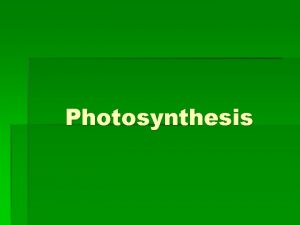Unit 3 A Photosynthesis Review 1 Which of









- Slides: 9

Unit 3 A Photosynthesis Review

1. Which of the following chemical equations represents photosynthesis? A. Carbon dioxide plus water yields glucose (sugar) and oxygen. B. Oxygen plus carbon dioxide yields water and glucose. C. Glucose plus oxygen yields carbon dioxide and water. D. Water plus glucose yields oxygen and carbon dioxide.

2. C 6 H 12 O 6 is the formula for A. B. C. D. Carbon dioxide oxygen glucose sucrose

3. A green pigment that traps energy from the sunlight, and is essential for photosynthesis is A. B. C. D. The mitochondria The chloroplast The nucleus The chlorophyll

4. In an experiment, the variable that YOU directly change is called the A. B. C. D. control Independent variable constant Dependent variable

5. The Calvin cycle is a series of reactions that use carbon dioxide to form carbohydrates. Another name for the Calvin cycle, which is also called the 2 nd phase of photosynthesis, is called the A. B. C. D. Light-dependent reactions Light-independent reactions Cellular respiration Fermentation

6. Leaves appear green because the green portion of the light that strikes them is A. B. C. D. Destroyed Changed to heat Absorbed Reflected

7. If photosynthesis suddenly stops, what might happen to Earth’s atmosphere? A. B. C. D. Carbon dioxide would suddenly increase. Oxygen would suddenly decrease. None of the above. A&B

8. In an experiment conducted to determine whether the green plants take in CO 2, a biologist filled a large beaker with aquarium water to which she added bromothymol blue. She exhaled CO 2 into the solution of bromothymol blue, which made the solution turn yellow. Then she placed a sprig of Elodea into the two test tubes. She left a third test tube without Elodea to serve as a control. She added the yellow bromothymol solution to all three test tubes and placed a stopper in each. Next, she placed all the test tubes in sunlight. After several hours in sunlight, the bromothymol solution in the test tubes with the Elodea turned blue. The bromothymol solution in the control remained yellow. What conclusion can be drawn from the experiment? Explain.
 Unit 10, unit 10 review tests, unit 10 general test
Unit 10, unit 10 review tests, unit 10 general test Chapter 8 photosynthesis vocabulary review
Chapter 8 photosynthesis vocabulary review What are the products of photosynthesis?
What are the products of photosynthesis? Algebra 2 unit 1 practice test
Algebra 2 unit 1 practice test Which of the following equations represents photosynthesis
Which of the following equations represents photosynthesis In which part of the cell does photosynthesis take place
In which part of the cell does photosynthesis take place Chapter review motion part a vocabulary review answer key
Chapter review motion part a vocabulary review answer key Uncontrollable spending ap gov
Uncontrollable spending ap gov Narrative review vs systematic review
Narrative review vs systematic review Systematic review definition
Systematic review definition

